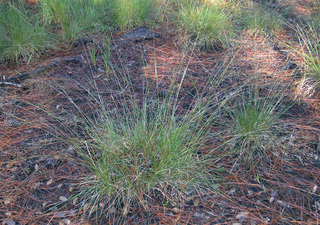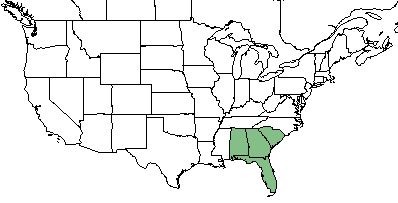Sporobolus floridanus
Revision as of 11:14, 22 January 2018 by Krobertson (talk | contribs)
| Sporobolus floridanus | |
|---|---|

| |
| Photo by Bobby Hattaway hosted at Discoverlife.org | |
| Scientific classification | |
| Kingdom: | Plantae |
| Division: | Magnoliophyta - Flowering plants |
| Class: | Liliopsida - Moncots |
| Order: | Poales |
| Family: | Poaceae |
| Genus: | Sporobolus |
| Species: | S. floridanus |
| Binomial name | |
| Sporobolus floridanus Chapm. | |

| |
| Natural range of Sporobolus floridanus from USDA NRCS Plants Database. | |
Common Name(s): Florida dropseed[1]
Contents
Taxonomic Notes
Description
‘’Sporobolus floridanus’’ is a monoecious perennial graminoid. [2]
Distribution
It can be found in South Carolina, Georgia, Florida, and Alabama.[1][2]
Ecology
Habitat
S. floridanus is found in wet savannas,[1][3], seepage bogs, and titi/cypress swamps and is abundant in wet pine savannas.[4] In north Florida mesic flatwoods S. floridanus occurred in 53% of plots with a mean coverage of 0.0613 m-2 and was the sole herbaceous indicator species this community type.[5]
Phenology
This species flowers from June through September.[1]
Fire ecology
In Georgia, the percent cover of S. floridanus increased from 0.4% after one growing season following a burn to 1.0% after 8 growing seasons.[6]
Conservation and Management
Cultivation and restoration
Photo Gallery
References and notes
- ↑ 1.0 1.1 1.2 1.3 Weakley A. S.(2015). Flora of the Southern and Mid-Atlantic States. Chapel Hill, NC: University of North Carolina Herbarium.
- ↑ 2.0 2.1 USDA, NRCS. (2016). The PLANTS Database (http://plants.usda.gov, 10 January 2018). National Plant Data Team, Greensboro, NC 27401-4901 USA.
- ↑ Nelson G. (10 January 2018) PanFlora. Retrieved from gilnelson.com/PanFlora/
- ↑ Drewa P. B., Platt W. J., and Moser E. B. (2002). Community structure along elevation gradients in headwater regions of longleaf pine savannas. Plant Ecology 160(1):61-78.
- ↑ Carr S. C., Robertson K. M., and Peet R. K. (2010). A vegetation classification of fire-dependent pinelands of Florida. Castanea 75(2):153-189.
- ↑ Lemon P. C. (1949). Successional responses of herbs in the longleaf-slash pine forest after fire. Ecology 30(2):135-145.